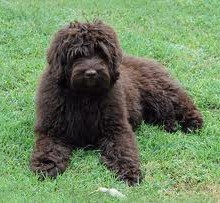Labradoodle
Lifestyle Needs

The name ‘Labradoodle’ is given to a cross between a Poodle and Labrador (so is not a breed in the accepted sense). This is usually a Standard Poodle but smaller Poodles are sometimes used to breed a smaller dog. Generally Labradoodles are largish dogs. The offspring of such a mating is known as an F1 cross and may have the added benefit of heterosis (or ‘hybrid vigor’). If two Labradoodles are mated together, this is known as F2. An F2 bred to an F2 will result in an F3, and so on. If an F1 is bred back to either parent breed it is an F1B. More details may be found here: www.labradoodletrust.com Temperament will vary but typically, if well socialised as puppies, the labradoodle will be a lively, good natured family pet. There is the potential for owners to less likely to be allergic to these dogs, but zero or low allergy is not guaranteed even within the same litter. It is claimed that these dogs will not shed their coats but this is not guaranteed. Coat type is varied. These large dogs will need plenty of exercise and stimulation, with regular opportunities to walk off lead. Regular, frequent and thorough grooming is needed.
Genetic Diversity
(Known as Coefficient of Inbreeding: 'COI'. It should be as low as possible.)
An F1 Labradodle’s COI will be 0%
F1B (an F1 bred back to either breed) should be no higher that 6.25% (ensuring no common ancestry within great grandparents, or third generation)
F2, F3, F4 should be no higher that 6.25% (using CCGB Club registration papers showing no common ancestry on 3 generation lineage record)
See 'A Beginners Guide to COI'
Gene Pool Size
(Known as Effective Population Size: 'EPS')
TBC
EPS is a measure of how many individuals are contributing genetically to a breed population. It is a measure of the size of the gene pool in a breed. Lower than 100 is considered critical by conservationists and below 50 brings a breed close to extinction. For more information see the Kennel Club article.
Health and Welfare Problems due to Conformation
(Body shape and physical characteristics)
The Labradoodle is free from exaggerations but the coat could be a problem if it is not kept clean and tangle free. If allowed to get tangled and matted, dirt and dust would collect and may lead to skin problems.
BVA/KC Health Schemes: www.bva.co.uk/chs
- Elbow dysplasia: score should be as low as possible
- Eye disease: Progressive retinal atrophy (PRA) (annual testing); Hereditary cataract (HC) (annual testing) Multifocal retinal dysplasia (MRD) (litter screening)
- Hip dysplasia: breed mean score (Poodle) 14; breed mean score (Labrador) 14; breed mean score (Labradoodle) 13 Both parents should be lower
Estimated Breeding Values (EBVs) : No EBVs are currently available for this breed
www.thekennelclub.org.uk/about-ebvs
DNA Tests Available
DogWellNet and IPFD Harmonisation of Genetic Testing for Dogs (HGTD)
www.dogwellnet.com/breeds
- CNM Centronuclear myopathy
- PRA Progressive retinal atrophy
- HNPK Hypertrophic nasal parakeratosis
- EIC Exercise Induced Collapse
- SD2 Skeletal dysplasia
- MCD Macular corneal dystrophy
- Stagardts disease
- vWD von Willebrands disease
Availability of a DNA test does not mean that it is always necessary or even desirable for breeders to use this test.
Other Breed-Specific Health Screening Schemes
Bi-annual test for Sebacious adentitis (skin disease).
Labradoodle Trust health webpage:
www.labradoodletrust.com/health_information.html
Ask the breeder to show you the certificates for the above tests/screening for both parents. If any of the above tests have not been considered necessary by the breeder (and there may be good reasons), ask her to explain why.
Other Diseases Reported
(For which there are currently no genetic or screening tests for sire or dam)
Check Other diseases in the relevant parent breeds
Ask the breeder about the medical history of the parents, grandparents and great grandparents. Consider carefully whether to purchase a puppy if some of these or other diseases are in the family line.
Ask about the breeder’s policy in cases of serious genetic diseases occurring to your puppy in later life. Good breeders will request to be informed of such events in order to improve future breeding decisions.
You are strongly advised to buy from a breeder who uses (or is prepared to use) the AWF Puppy Contract and Puppy Information Pack (PIP): www.puppycontract.org.uk
The breeder should also be familiar with the CFSG/DBRG Code of Practice for Dog Breeding
Or the Kennel Club’s Assured Breeders Scheme Standard and Guidance:
Standard PDF | Guidance PDF